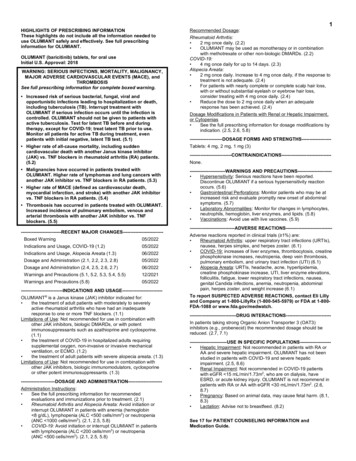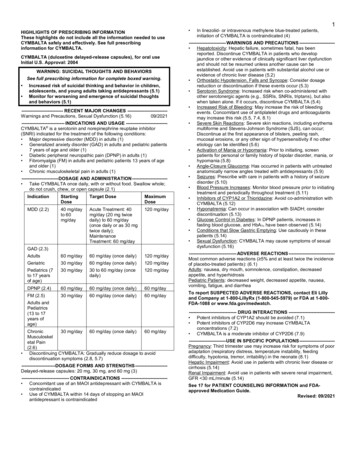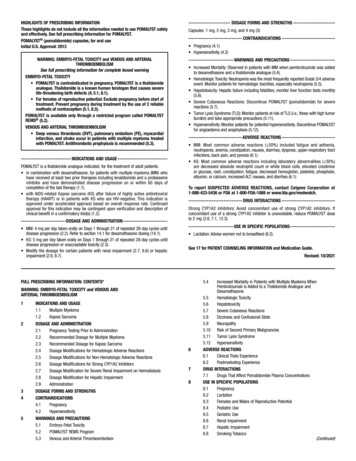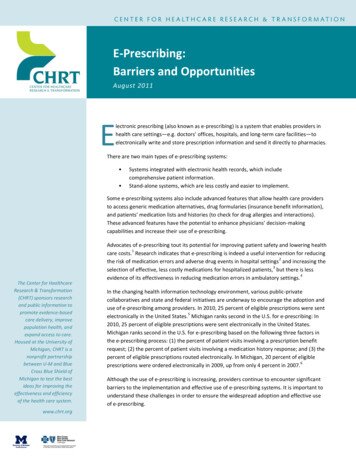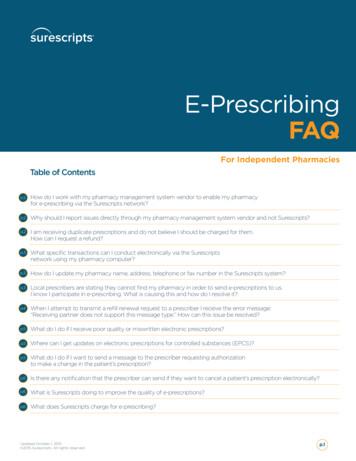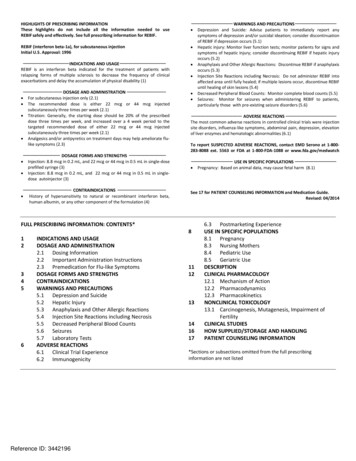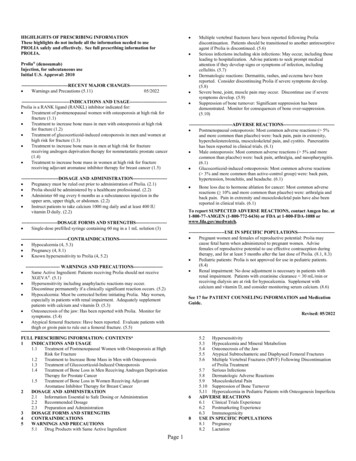
Transcription
HIGHLIGHTS OF PRESCRIBING INFORMATIONThese highlights do not include all the information needed to usePROLIA safely and effectively. See full prescribing information forPROLIA. Prolia (denosumab)Injection, for subcutaneous useInitial U.S. Approval: 2010 ------------------------------RECENT MAJOR CHANGES----------------------- Warnings and Precautions (5.11)05/2022 -------------------------------INDICATIONS AND USAGE-----------------------Prolia is a RANK ligand (RANKL) inhibitor indicated for: Treatment of postmenopausal women with osteoporosis at high risk forfracture (1.1) Treatment to increase bone mass in men with osteoporosis at high riskfor fracture (1.2) Treatment of glucocorticoid-induced osteoporosis in men and women athigh risk for fracture (1.3) Treatment to increase bone mass in men at high risk for fracturereceiving androgen deprivation therapy for nonmetastatic prostate cancer(1.4) Treatment to increase bone mass in women at high risk for fracturereceiving adjuvant aromatase inhibitor therapy for breast cancer (1.5) ----------------------------ADVERSE REACTIONS-------------------------------- Postmenopausal osteoporosis: Most common adverse reactions ( 5%and more common than placebo) were: back pain, pain in extremity,hypercholesterolemia, musculoskeletal pain, and cystitis. Pancreatitishas been reported in clinical trials. (6.1) Male osteoporosis: Most common adverse reactions ( 5% and morecommon than placebo) were: back pain, arthralgia, and nasopharyngitis.(6.1) Glucocorticoid-induced osteoporosis: Most common adverse reactions( 3% and more common than active-control group) were: back pain,hypertension, bronchitis, and headache. (6.1)------------------------DOSAGE AND ADMINISTRATION--------------------- Pregnancy must be ruled out prior to administration of Prolia. (2.1) Prolia should be administered by a healthcare professional. (2.2) Administer 60 mg every 6 months as a subcutaneous injection in theupper arm, upper thigh, or abdomen. (2.2) Instruct patients to take calcium 1000 mg daily and at least 400 IUvitamin D daily. (2.2) -----------------------USE IN SPECIFIC POPULATIONS----------------------- Pregnant women and females of reproductive potential: Prolia maycause fetal harm when administered to pregnant women. Advisefemales of reproductive potential to use effective contraception duringtherapy, and for at least 5 months after the last dose of Prolia. (8.1, 8.3) Pediatric patients: Prolia is not approved for use in pediatric patients.(8.4) Renal impairment: No dose adjustment is necessary in patients withrenal impairment. Patients with creatinine clearance 30 mL/min orreceiving dialysis are at risk for hypocalcemia. Supplement withcalcium and vitamin D, and consider monitoring serum calcium. NS------------------------------ Hypocalcemia (4, 5.3) Pregnancy (4, 8.1) Known hypersensitivity to Prolia (4, 5.2) Bone loss due to hormone ablation for cancer: Most common adversereactions ( 10% and more common than placebo) were: arthralgia andback pain. Pain in extremity and musculoskeletal pain have also beenreported in clinical trials. (6.1)To report SUSPECTED ADVERSE REACTIONS, contact Amgen Inc. at1-800-77-AMGEN (1-800-772-6436) or FDA at 1-800-FDA-1088 GE FORMS AND STRENGTHS------------------- Single-dose prefilled syringe containing 60 mg in a 1 mL solution (3) Multiple vertebral fractures have been reported following Proliadiscontinuation. Patients should be transitioned to another antiresorptiveagent if Prolia is discontinued. (5.6)Serious infections including skin infections: May occur, including thoseleading to hospitalization. Advise patients to seek prompt medicalattention if they develop signs or symptoms of infection, includingcellulitis. (5.7)Dermatologic reactions: Dermatitis, rashes, and eczema have beenreported. Consider discontinuing Prolia if severe symptoms develop.(5.8)Severe bone, joint, muscle pain may occur. Discontinue use if severesymptoms develop. (5.9)Suppression of bone turnover: Significant suppression has beendemonstrated. Monitor for consequences of bone over-suppression.(5.10)---------------------- WARNINGS AND PRECAUTIONS------------------Same Active Ingredient: Patients receiving Prolia should not receiveXGEVA . (5.1)Hypersensitivity including anaphylactic reactions may occur.Discontinue permanently if a clinically significant reaction occurs. (5.2)Hypocalcemia: Must be corrected before initiating Prolia. May worsen,especially in patients with renal impairment. Adequately supplementpatients with calcium and vitamin D. (5.3)Osteonecrosis of the jaw: Has been reported with Prolia. Monitor forsymptoms. (5.4)Atypical femoral fractures: Have been reported. Evaluate patients withthigh or groin pain to rule out a femoral fracture. (5.5)See 17 for PATIENT COUNSELING INFORMATION and MedicationGuide.Revised: 05/2022FULL PRESCRIBING INFORMATION: CONTENTS*1INDICATIONS AND USAGE1.1Treatment of Postmenopausal Women with Osteoporosis at HighRisk for Fracture1.2Treatment to Increase Bone Mass in Men with Osteoporosis1.3Treatment of Glucocorticoid-Induced Osteoporosis1.4Treatment of Bone Loss in Men Receiving Androgen DeprivationTherapy for Prostate Cancer1.5Treatment of Bone Loss in Women Receiving AdjuvantAromatase Inhibitor Therapy for Breast Cancer2DOSAGE AND ADMINISTRATION2.1Information Essential to Safe Dosing or Administration2.2Recommended Dosage2.3Preparation and Administration3DOSAGE FORMS AND STRENGTHS4CONTRAINDICATIONS5WARNINGS AND PRECAUTIONS5.1Drug Products with Same Active Ingredient5.25.35.45.55.668Page 1HypersensitivityHypocalcemia and Mineral MetabolismOsteonecrosis of the JawAtypical Subtrochanteric and Diaphyseal Femoral FracturesMultiple Vertebral Fractures (MVF) Following Discontinuationof Prolia Treatment5.7Serious Infections5.8Dermatologic Adverse Reactions5.9Musculoskeletal Pain5.10 Suppression of Bone Turnover5.11 Hypercalcemia in Pediatric Patients with Osteogenesis ImperfectaADVERSE REACTIONS6.1Clinical Trials Experience6.2Postmarketing Experience6.3ImmunogenicityUSE IN SPECIFIC POPULATIONS8.1Pregnancy8.2Lactation
101112138.3Females and Males of Reproductive Potential8.4Pediatric Use8.5Geriatric Use8.6Renal Impairment8.7Hepatic ImpairmentOVERDOSAGEDESCRIPTIONCLINICAL PHARMACOLOGY12.1 Mechanism of Action12.2 Pharmacodynamics12.3 PharmacokineticsNONCLINICAL TOXICOLOGY13.1 Carcinogenesis, Mutagenesis, Impairment of Fertility14161713.2 Animal Toxicology and/or PharmacologyCLINICAL STUDIES14.1 Treatment of Postmenopausal Women with Osteoporosis14.2 Treatment to Increase Bone Mass in Men with Osteoporosis14.3 Treatment of Glucocorticoid-Induced Osteoporosis14.4 Treatment of Bone Loss in Men with Prostate Cancer14.5 Treatment of Bone Loss in Women with Breast CancerHOW SUPPLIED/STORAGE AND HANDLINGPATIENT COUNSELING INFORMATION* Sections or subsections omitted from the full prescribing informationare not listed.Page 2
FULL PRESCRIBING INFORMATION1INDICATIONS AND USAGE1.1Treatment of Postmenopausal Women with Osteoporosis at High Risk for FractureProlia is indicated for the treatment of postmenopausal women with osteoporosis at high risk for fracture,defined as a history of osteoporotic fracture, or multiple risk factors for fracture; or patients who havefailed or are intolerant to other available osteoporosis therapy. In postmenopausal women withosteoporosis, Prolia reduces the incidence of vertebral, nonvertebral, and hip fractures [see ClinicalStudies (14.1)].1.2Treatment to Increase Bone Mass in Men with OsteoporosisProlia is indicated for treatment to increase bone mass in men with osteoporosis at high risk for fracture,defined as a history of osteoporotic fracture, or multiple risk factors for fracture; or patients who havefailed or are intolerant to other available osteoporosis therapy [see Clinical Studies (14.2)].1.3Treatment of Glucocorticoid-Induced OsteoporosisProlia is indicated for the treatment of glucocorticoid-induced osteoporosis in men and women at highrisk of fracture who are either initiating or continuing systemic glucocorticoids in a daily dosageequivalent to 7.5 mg or greater of prednisone and expected to remain on glucocorticoids for at least6 months. High risk of fracture is defined as a history of osteoporotic fracture, multiple risk factors forfracture, or patients who have failed or are intolerant to other available osteoporosis therapy [see ClinicalStudies (14.3)].1.4Treatment of Bone Loss in Men Receiving Androgen Deprivation Therapy for ProstateCancerProlia is indicated as a treatment to increase bone mass in men at high risk for fracture receiving androgendeprivation therapy for nonmetastatic prostate cancer. In these patients Prolia also reduced the incidenceof vertebral fractures [see Clinical Studies (14.4)].1.5Treatment of Bone Loss in Women Receiving Adjuvant Aromatase Inhibitor Therapy forBreast CancerProlia is indicated as a treatment to increase bone mass in women at high risk for fracture receivingadjuvant aromatase inhibitor therapy for breast cancer [see Clinical Studies (14.5)].2DOSAGE AND ADMINISTRATION2.1Information Essential to Safe Dosing or AdministrationPregnancy must be ruled out prior to administration of Prolia. Perform pregnancy testing in all females ofreproductive potential prior to administration of Prolia. Based on findings in animals, Prolia can causefetal harm when administered to pregnant women [see Use in Specific Populations (8.1, 8.3)].Page 3
2.2Recommended DosageProlia should be administered by a healthcare professional.The recommended dose of Prolia is 60 mg administered as a single subcutaneous injection once every6 months. Administer Prolia via subcutaneous injection in the upper arm, the upper thigh, or theabdomen. All patients should receive calcium 1000 mg daily and at least 400 IU vitamin D daily[see Warnings and Precautions (5.3)].If a dose of Prolia is missed, administer the injection as soon as the patient is available. Thereafter,schedule injections every 6 months from the date of the last injection.2.3Preparation and AdministrationVisually inspect Prolia for particulate matter and discoloration prior to administration whenever solutionand container permit. Prolia is a clear, colorless to pale yellow solution that may contain trace amounts oftranslucent to white proteinaceous particles. Do not use if the solution is discolored or cloudy or if thesolution contains many particles or foreign particulate matter.Latex Allergy: People sensitive to latex should not handle the gray needle cap on the single-dose prefilledsyringe, which contains dry natural rubber (a derivative of latex).Prior to administration, Prolia may be removed from the refrigerator and brought to room temperature (upto 25 C/77 F) by standing in the original container. This generally takes 15 to 30 minutes. Do not warmProlia in any other way [see How Supplied/Storage and Handling (16)].Instructions for Prefilled Syringe with Needle Safety GuardIMPORTANT: In order to minimize accidental needlesticks, the Prolia single-dose prefilled syringe willhave a green safety guard; manually activate the safety guard after the injection is given.DO NOT slide the green safety guard forward over the needle before administering the injection; it willlock in place and prevent injection.Safety Guard(green plastic)WindowPlungerNeedle Cap(gray rubber)Finger Grip(clear plastic)Activate the green safety guard (slide over the needle) after the injection.The gray needle cap on the single-dose prefilled syringe contains dry natural rubber (a derivative oflatex); people sensitive to latex should not handle the cap.Page 4
Step 1: Remove Gray Needle CapRemove needle cap.Step 2: Administer Subcutaneous InjectionUpper ThighChoose an injection site. Therecommended injection sites forProlia include: the upper armOR the upper thigh OR theabdomen.Upper ArmAbdomenInsert needle and inject allthe liquid subcutaneously.Do not administer into muscleor blood vessel.Page 5
DO NOT put gray needle cap back on needle.Step 3: Immediately Slide Green Safety Guard Over NeedleWith the needle pointing away from you.Hold the prefilled syringe by the clear plastic finger grip with one hand. Then, with the other hand, graspthe green safety guard by its base and gently slide it towards the needle until the green safety guard lockssecurely in place and/or you hear a “click”. DO NOT grip the green safety guard too firmly - it willmove easily if you hold and slide it gently.Hold clear finger grip.Gently slide green safety guardover needle and lock securely inplace. Do not grip green safetyguard too firmly when sliding overneedle.Immediately dispose of the syringe and needle cap in the nearest sharps container. DO NOT put theneedle cap back on the used syringe.3 4DOSAGE FORMS AND STRENGTHS1 mL of a 60 mg/mL solution in a single-dose prefilled syringe.CONTRAINDICATIONSProlia is contraindicated in: Hypocalcemia: Pre-existing hypocalcemia must be corrected prior to initiating therapy with Prolia[see Warnings and Precautions (5.3)]. Pregnancy: Prolia may cause fetal harm when administered to a pregnant woman. In women ofreproductive potential, pregnancy testing should be performed prior to initiating treatment withProlia [see Use in Specific Populations (8.1)]. Hypersensitivity: Prolia is contraindicated in patients with a history of systemic hypersensitivity toany component of the product. Reactions have included anaphylaxis, facial swelling, and urticaria[see Warnings and Precautions (5.2), Adverse Reactions (6.2)].Page 6
5WARNINGS AND PRECAUTIONS5.1Drug Products with Same Active IngredientProlia contains the same active ingredient (denosumab) found in Xgeva. Patients receiving Prolia shouldnot receive Xgeva.5.2HypersensitivityClinically significant hypersensitivity including anaphylaxis has been reported with Prolia. Symptomshave included hypotension, dyspnea, throat tightness, facial and upper airway edema, pruritus, andurticaria. If an anaphylactic or other clinically significant allergic reaction occurs, initiate appropriatetherapy and discontinue further use of Prolia [see Contraindications (4), Adverse Reactions (6.2)].5.3Hypocalcemia and Mineral MetabolismHypocalcemia may be exacerbated by the use of Prolia. Pre-existing hypocalcemia must be correctedprior to initiating therapy with Prolia. In patients predisposed to hypocalcemia and disturbances ofmineral metabolism (e.g. history of hypoparathyroidism, thyroid surgery, parathyroid surgery,malabsorption syndromes, excision of small intestine, severe renal impairment [creatinineclearance 30 mL/min] or receiving dialysis, treatment with other calcium-lowering drugs), clinicalmonitoring of calcium and mineral levels (phosphorus and magnesium) is highly recommended within 14days of Prolia injection. In some postmarketing cases, hypocalcemia persisted for weeks or months andrequired frequent monitoring and intravenous and/or oral calcium replacement, with or withoutvitamin D.Hypocalcemia following Prolia administration is a significant risk in patients with severe renalimpairment (creatinine clearance 30 mL/min) or receiving dialysis. These patients may also developmarked elevations of serum parathyroid hormone (PTH). Concomitant use of calcimimetic drugs mayworsen hypocalcemia risk and serum calcium should be closely monitored. Instruct all patients withsevere renal impairment, including those receiving dialysis, about the symptoms of hypocalcemia and theimportance of maintaining calcium levels with adequate calcium and vitamin D supplementation.Adequately supplement all patients with calcium and vitamin D [see Dosage and Administration (2.1),Contraindications (4), Adverse Reactions (6.1) and Patient Counseling Information (17)].5.4Osteonecrosis of the JawOsteonecrosis of the jaw (ONJ), which can occur spontaneously, is generally associated with toothextraction and/or local infection with delayed healing. ONJ has been reported in patients receivingdenosumab [see Adverse Reactions (6.1)]. A routine oral exam should be performed by the prescriberprior to initiation of Prolia treatment. A dental examination with appropriate preventive dentistry isrecommended prior to treatment with Prolia in patients with risk factors for ONJ such as invasive dentalprocedures (e.g. tooth extraction, dental implants, oral surgery), diagnosis of cancer, concomitanttherapies (e.g. chemotherapy, corticosteroids, angiogenesis inhibitors), poor oral hygiene, and comorbiddisorders (e.g. periodontal and/or other pre-existing dental disease, anemia, coagulopathy, infection,ill-fitting dentures). Good oral hygiene practices should be maintained during treatment with Prolia.Concomitant administration of drugs associated with ONJ may increase the risk of developing ONJ. Therisk of ONJ may increase with duration of exposure to Prolia.Page 7
For patients requiring invasive dental procedures, clinical judgment of the treating physician and/or oralsurgeon should guide the management plan of each patient based on individual benefit-risk assessment.Patients who are suspected of having or who develop ONJ while on Prolia should receive care by a dentistor an oral surgeon. In these patients, extensive dental surgery to treat ONJ may exacerbate the condition.Discontinuation of Prolia therapy should be considered based on individual benefit-risk assessment.5.5Atypical Subtrochanteric and Diaphyseal Femoral FracturesAtypical low energy or low trauma fractures of the shaft have been reported in patients receiving Prolia[see Adverse Reactions (6.1)]. These fractures can occur anywhere in the femoral shaft from just belowthe lesser trochanter to above the supracondylar flare and are transverse or short oblique in orientationwithout evidence of comminution. Causality has not been established as these fractures also occur inosteoporotic patients who have not been treated with antiresorptive agents.Atypical femoral fractures most commonly occur with minimal or no trauma to the affected area. Theymay be bilateral, and many patients report prodromal pain in the affected area, usually presenting as dull,aching thigh pain, weeks to months before a complete fracture occurs. A number of reports note thatpatients were also receiving treatment with glucocorticoids (e.g. prednisone) at the time of fracture.During Prolia treatment, patients should be advised to report new or unusual thigh, hip, or groin pain.Any patient who presents with thigh or groin pain should be suspected of having an atypical fracture andshould be evaluated to rule out an incomplete femur fracture. Patient presenting with an atypical femurfracture should also be assessed for symptoms and signs of fracture in the contralateral limb. Interruptionof Prolia therapy should be considered, pending a benefit-risk assessment, on an individual basis.5.6Multiple Vertebral Fractures (MVF) Following Discontinuation of Prolia TreatmentFollowing discontinuation of Prolia treatment, fracture risk increases, including the risk of multiplevertebral fractures. Treatment with Prolia results in significant suppression of bone turnover andcessation of Prolia treatment results in increased bone turnover above pretreatment values 9 months afterthe last dose of Prolia. Bone turnover then returns to pretreatment values 24 months after the last dose ofProlia. In addition, bone mineral density returns to pretreatment values within 18 months after the lastinjection [see Clinical Pharmacology (12.2), Clinical Studies (14.1)].New vertebral fractures occurred as early as 7 months (on average 19 months) after the last dose of Prolia.Prior vertebral fracture was a predictor of multiple vertebral fractures after Prolia discontinuation.Evaluate an individual’s benefit-risk before initiating treatment with Prolia.If Prolia treatment is discontinued, patients should be transitioned to an alternative antiresorptive therapy[see Adverse Reactions (6.1)].5.7Serious InfectionsIn a clinical trial of over 7800 women with postmenopausal osteoporosis, serious infections leading tohospitalization were reported more frequently in the Prolia group than in the placebo group [see AdverseReactions (6.1)]. Serious skin infections, as well as infections of the abdomen, urinary tract, and ear,were more frequent in patients treated with Prolia. Endocarditis was also reported more frequently inProlia-treated patients. The incidence of opportunistic infections was similar between placebo and Proliagroups, and the overall incidence of infections was similar between the treatment groups. Advise patientsPage 8
to seek prompt medical attention if they develop signs or symptoms of severe infection, includingcellulitis.Patients on concomitant immunosuppressant agents or with impaired immune systems may be atincreased risk for serious infections. Consider the benefit-risk profile in such patients before treating withProlia. In patients who develop serious infections while on Prolia, prescribers should assess the need forcontinued Prolia therapy.5.8Dermatologic Adverse ReactionsIn a large clinical trial of over 7800 women with postmenopausal osteoporosis, epidermal and dermaladverse events such as dermatitis, eczema, and rashes occurred at a significantly higher rate in the Proliagroup compared to the placebo group. Most of these events were not specific to the injection site[see Adverse Reactions (6.1)]. Consider discontinuing Prolia if severe symptoms develop.5.9Musculoskeletal PainIn postmarketing experience, severe and occasionally incapacitating bone, joint, and/or muscle pain hasbeen reported in patients taking Prolia [see Adverse Reactions (6.2)]. The time to onset of symptomsvaried from one day to several months after starting Prolia. Consider discontinuing use if severesymptoms develop [see Patient Counseling Information (17)].5.10Suppression of Bone TurnoverIn clinical trials in women with postmenopausal osteoporosis, treatment with Prolia resulted in significantsuppression of bone remodeling as evidenced by markers of bone turnover and bone histomorphometry[see Clinical Pharmacology (12.2), Clinical Studies (14.1)]. The significance of these findings and theeffect of long-term treatment with Prolia are unknown. The long-term consequences of the degree ofsuppression of bone remodeling observed with Prolia may contribute to adverse outcomes such asosteonecrosis of the jaw, atypical fractures, and delayed fracture healing. Monitor patients for theseconsequences.5.11Hypercalcemia in Pediatric Patients with Osteogenesis ImperfectaProlia is not approved for use in pediatric patients. Hypercalcemia has been reported in pediatric patientswith osteogenesis imperfecta treated with denosumab products, including Prolia. Some cases requiredhospitalization [see Pediatric Use (8.4)].6ADVERSE REACTIONSThe following serious adverse reactions are discussed below and also elsewhere in the labeling: Hypocalcemia [see Warnings and Precautions (5.3)]Serious Infections [see Warnings and Precautions (5.7)]Dermatologic Adverse Reactions [see Warnings and Precautions (5.8)]Osteonecrosis of the Jaw [see Warnings and Precautions (5.4)]Atypical Subtrochanteric and Diaphyseal Femoral Fractures [see Warnings and Precautions (5.5)]Multiple Vertebral Fractures (MVF) Following Discontinuation of Prolia Treatment [see Warningsand Precautions (5.6)]Page 9
The most common adverse reactions reported with Prolia in patients with postmenopausal osteoporosisare back pain, pain in extremity, musculoskeletal pain, hypercholesterolemia, and cystitis.The most common adverse reactions reported with Prolia in men with osteoporosis are back pain,arthralgia, and nasopharyngitis.The most common adverse reactions reported with Prolia in patients with glucocorticoid-inducedosteoporosis are back pain, hypertension, bronchitis, and headache.The most common (per patient incidence 10%) adverse reactions reported with Prolia in patients withbone loss receiving androgen deprivation therapy for prostate cancer or adjuvant aromatase inhibitortherapy for breast cancer are arthralgia and back pain. Pain in extremity and musculoskeletal pain havealso been reported in clinical trials.The most common adverse reactions leading to discontinuation of Prolia in patients with postmenopausalosteoporosis are back pain and constipation.To report Adverse Reactions with Prolia , please call Amgen Medical Information at 1-800-772-6436,email medinfo@amgen.com, or report the event at FDA MedWatch.6.1Clinical Trials ExperienceBecause clinical studies are conducted under widely varying conditions, adverse reaction rates observedin the clinical studies of a drug cannot be directly compared to rates in the clinical studies of another drugand may not reflect the rates observed in clinical practice.Treatment of Postmenopausal Women with OsteoporosisThe safety of Prolia in the treatment of postmenopausal osteoporosis was assessed in a 3-year,randomized, double-blind, placebo-controlled, multinational study of 7808 postmenopausal women aged60 to 91 years. A total of 3876 women were exposed to placebo and 3886 women were exposed to Proliaadministered subcutaneously once every 6 months as a single 60 mg dose. All women were instructed totake at least 1000 mg of calcium and 400 IU of vitamin D supplementation per day.The incidence of all-cause mortality was 2.3% (n 90) in the placebo group and 1.8% (n 70) in theProlia group. The incidence of nonfatal serious adverse events was 24.2% in the placebo group and25.0% in the Prolia group. The percentage of patients who withdrew from the study due to adverse eventswas 2.1% and 2.4% for the placebo and Prolia groups, respectively.Adverse reactions reported in 2% of postmenopausal women with osteoporosis and more frequently inthe Prolia-treated women than in the placebo-treated women are shown in the table below.Table 1. Adverse Reactions Occurring in 2% of Patients with Osteoporosis and More Frequentlythan in Placebo-treated PatientsProliaPlaceboSYSTEM ORGAN CLASS(N 3886)(N 3876)Preferred Termn (%)n (%)BLOOD AND LYMPHATIC SYSTEM DISORDERSAnemiaPage 10129 (3.3)107 (2.8)
Prolia(N 3886)n (%)Placebo(N 3876)n (%)CARDIAC DISORDERSAngina pectorisAtrial fibrillation101 (2.6)79 (2.0)87 (2.2)77 (2.0)EAR AND LABYRINTH DISORDERSVertigo195 (5.0)187 (4.8)GASTROINTESTINAL DISORDERSAbdominal pain upperFlatulenceGastroesophageal reflux disease129 (3.3)84 (2.2)80 (2.1)111 (2.9)53 (1.4)66 (1.7)GENERAL DISORDERS AND ADMINISTRATION SITECONDITIONSEdema peripheralAsthenia189 (4.9)90 (2.3)155 (4.0)73 (1.9)INFECTIONS AND INFESTATIONSCystitisUpper respiratory tract infectionPneumoniaPharyngitisHerpes zoster228 (5.9)190 (4.9)152 (3.9)91 (2.3)79 (2.0)225 (5.8)167 (4.3)150 (3.9)78 (2.0)72 (1.9)METABOLISM AND NUTRITION DISORDERSHypercholesterolemia280 (7.2)236 (6.1)1347 (34.7)453 (11.7)297 (7.6)142 (3.7)114 (2.9)82 (2.1)1340 (34.6)430 (11.1)291 (7.5)117 (3.0)94 (2.4)64 (1.7)178 (4.6)149 (3.8)SYSTEM ORGAN CLASSPreferred TermMUSCULOSKELETAL AND CONNECTIVE TISSUEDISORDERSBack painPain in extremityMusculoskeletal painBone painMyalgiaSpinal osteoarthritisNERVOUS SYSTEM DISORDERSSciaticaPage 11
SYSTEM ORGAN CLASSPreferred TermPSYCHIATRIC DISORDERSInsomniaSKIN AND SUBCUTANEOUS TISSUE DISORDERSRashPruritusProlia(N 3886)n (%)Placebo(N 3876)n (%)126 (3.2)122 (3.1)96 (2.5)87 (2.2)79 (2.0)82 (2.1)HypocalcemiaDecreases in serum calcium levels to less than 8.5 mg/dL at any visit were reported in 0.4% women in theplacebo group and 1.7% women in the Prolia group. The nadir in serum calcium level occurs atapproximately day 10 after Prolia dosing in subjects with normal renal function.In clinical studies, subjects with impaired renal function were more likely to have greater reductions inserum calcium levels compared to subjects with normal renal function. In a study of 55 subjects withvarying degrees of renal function, serum calcium levels 7.5 mg/dL or symptomatic hypocalcemia wereobserved in 5 subjects. These included no subjects in the normal renal function group, 10% of subjects inthe creatinine clearance 50 to 80 mL/min group, 29% of subjects in the creatinine clearance 30 mL/mingroup, and 29% of subjects in the hemodialysis group. These subjects did not receive calcium andvitamin D supplementation. In a study of 4550 postmenopausal women with osteoporosis, the meanchange from baseline in serum calcium level 10 days after Prolia dosing was -5.5% in subjects withcreatinine clearance 30 mL/min vs. -3.1% in subjects with creatinine clearance 30 mL/min.Serious InfectionsReceptor activator of nuclear factor kappa-B ligand (RANKL) is expressed on activated T and Blymphocytes and in lymph nodes. Therefore, a RANKL inhibitor such as Prolia may increase the risk ofinfection.In the clinical study of 7808 postmenopausal women with osteoporosis, the incidence of infectionsresulting in death was 0.2% in both placebo and Prolia treatment groups. However, the incidence ofnonfatal serious infections was 3.3% in the placebo and 4.0% in the Prolia groups. Hospitalizations dueto serious infections in the abdomen (0.7% placebo vs. 0.9% Prolia), urinary tract (0.5% placebo vs.0.7% Prolia), and ear (0.0% placebo vs. 0.1% Prolia) were reported. Endocarditis was reported in noplacebo patients and 3 patients receiving Prolia.Skin infections, including erysipelas and cellulitis, leading to hospitalization were reported morefrequently in patients treated with Prolia ( 0.1% placebo vs. 0.4% Prolia).The incidence of opportunistic infections was similar to that reported with placebo.Dermatologic Adverse ReactionsA significantly higher number of patients treated with Prolia developed epidermal and dermal adverseevents (such as dermatitis, eczema, and rashes), with these events reported in 8.2% of the placebo and10.8% of the Prolia groups (p 0.0001). Most of these events were not specif
reactions ( 10% and more common than placebo) were: arthralgia and back pain. Pain in extremity and musculoskeletal pain have also been reported in clinical trials. (6.1) To report SUSPECTED ADVERSE REACTIONS, contact Amgen Inc. at 1-800-77-AMGEN (1-800-772-6436) or FDA at 1-800-FDA-1088 or .

